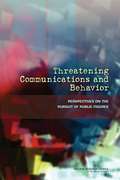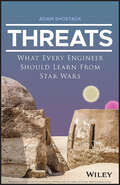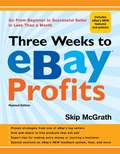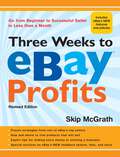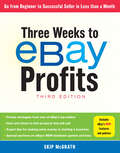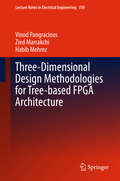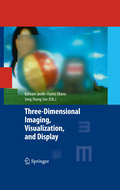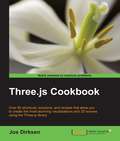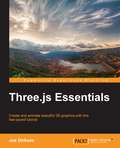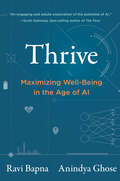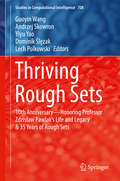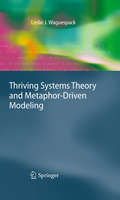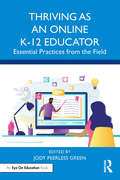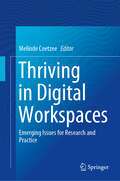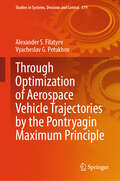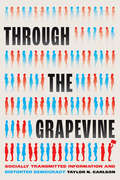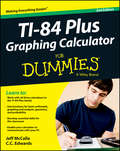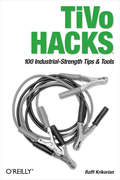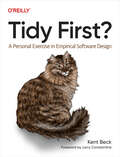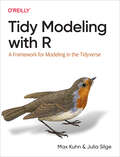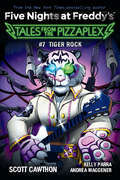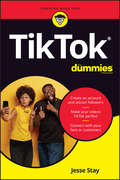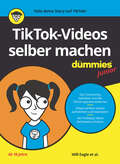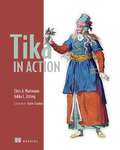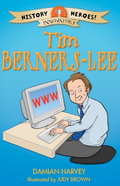- Table View
- List View
Threatening Communications and Behavior: Perspectives on the Pursuit of Public Figures
by National Research Council of the National AcademiesToday's world of rapid social, technological, and behavioral change provides new opportunities for communications with few limitations of time and space. Through these communications, people leave behind an ever-growing collection of traces of their daily activities, including digital footprints provided by text, voice, and other modes of communication. Meanwhile, new techniques for aggregating and evaluating diverse and multimodal information sources are available to security services that must reliably identify communications indicating a high likelihood of future violence. In the context of this changed and changing world of communications and behavior, the Board on Behavioral, Cognitive, and Sensory Sciences of the National Research Council presents this volume of three papers as one portion of the vast subject of threatening communications and behavior. The papers review the behavioral and social sciences research on the likelihood that someone who engages in abnormal and/or threatening communications will actually then try to do harm. The focus is on how the scientific knowledge can inform and advance future research on threat assessments, in part by considering the approaches and techniques used to analyze communications and behavior in the dynamic context of today's world. The papers in the collection were written within the context of protecting high-profile public figures from potential attach or harm. The research, however, is broadly applicable to U.S. national security including potential applications for analysis of communications from leaders of hostile nations and public threats from terrorist groups. This work highlights the complex psychology of threatening communications and behavior, and it offers knowledge and perspectives from multiple domains that contribute to a deeper understanding of the value of communications in predicting and preventing violent behaviors.
Threats: What Every Engineer Should Learn From Star Wars
by Adam ShostackSecure your applications with help from your favorite Jedi masters In Threats: What Every Engineer Should Learn From Star Wars, accomplished security expert and educator Adam Shostack delivers an easy-to-read and engaging discussion of security threats and how to develop secure systems. The book will prepare you to take on the Dark Side as you learn—in a structured and memorable way—about the threats to your systems. You’ll move from thinking of security issues as clever one-offs and learn to see the patterns they follow. This book brings to light the burning questions software developers should be asking about securing systems, and answers them in a fun and entertaining way, incorporating cybersecurity lessons from the much-loved Star Wars series. You don’t need to be fluent in over 6 million forms of exploitation to face these threats with the steely calm of a Jedi master. You’ll also find: Understandable and memorable introductions to the most important threats that every engineer should know Straightforward software security frameworks that will help engineers bake security directly into their systems Strategies to align large teams to achieve application security in today’s fast-moving and agile world Strategies attackers use, like tampering, to interfere with the integrity of applications and systems, and the kill chains that combine these threats into fully executed campaignsAn indispensable resource for software developers and security engineers, Threats: What Every Engineer Should Learn From Star Wars belongs on the bookshelves of everyone delivering or operating technology: from engineers to executives responsible for shipping secure code.
Three Weeks to Ebay Profits: Go from Beginner to Successful Seller in Less Than a Month (revised edition)
by Skip McgrathThe essential guide to building an eBay business and making money in just twenty-one days--now with information on the company's new modified fee structures, feedback system, and other changes.
Three Weeks to eBay® Profits, Revised Edition: Go from Beginner to Successful Seller in Less than a Month
by Skip McGrathSolid gold information from a Gold-level seller! Veteran eBay expert and author Skip McGrath presents a completely updated guide to the new, drastically altered site.Under its new management, eBay has instituted many important changes, and this revised edition addresses the company’s modified fee structures, new (and controversial) feedback system, and more, while guiding sellers through the steps of starting, expanding, and automating a successful eBay business. McGrath offers tips on what’s popular with eBay’s buyers, as well as on drop shipping, controlling costs, managing inventory, writing headlines and descriptions that sell, launching your first auctions, and more.
Three Weeks to eBay® Profits, Third Edition: Go From Beginner to Successful Seller in Less than a Month
by Skip McGrathSince its release, Skip McGraths classic guide to eBay® has been a bestseller—and this completely updated edition will help you navigate the popular websites sweeping rule changes. It covers all the revised features, from the new Top Rated Seller designation to the widespread integration of services such as Paypal and automated UPS/USPS shipping. Sellers will make more money than ever!
Three-Dimensional Design Methodologies for Tree-based FPGA Architecture
by Vinod Pangracious Zied Marrakchi Habib MehrezThis book focuses on the development of 3D design and implementation methodologies for Tree-based FPGA architecture. It also stresses the needs for new and augmented 3D CAD tools to support designs such as, the design for 3D, to manufacture high performance 3D integrated circuits and reconfigurable FPGA-based systems. This book was written as a text that covers the foundations of 3D integrated system design and FPGA architecture design. It was written for the use in an elective or core course at the graduate level in field of Electrical Engineering, Computer Engineering and Doctoral Research programs. No previous background on 3D integration is required, nevertheless fundamental understanding of 2D CMOS VLSI design is required. It is assumed that reader has taken the core curriculum in Electrical Engineering or Computer Engineering, with courses like CMOS VLSI design, Digital System Design and Microelectronics Circuits being the most important. It is accessible for self-study by both senior students and professionals alike.
Three-Dimensional Imaging, Visualization, and Display
by Bahram Javidi Fumio Okano Jung-Young SonThis book will describe recent developments, as well as the prospects and challenges facing 3D moving picture systems and devices, including binocular, multi-view, holographic, and image reproduction techniques. Optical systems, display instruments, and image capture techniques will be covered. The online supplement will include full color movies of experiments describing recent advances in 3D movies. This is the first state-of-the-art book on this subject that efficiently integrating the background material with new advances and applications and includes movies of 3D display systems.
Three.js Cookbook
by Jos DirksenThis book is ideal for anyone who already knows JavaScript and would like to get a broad understanding of Three.js quickly, or for those of you who have a basic grasp of using Three.js but want to really make an impact with your 3D visualizations by learning its advanced features. To apply the recipes in this book you don't need to know anything about WebGL; all you need is some general knowledge about JavaScript and HTML.
Three.js Essentials
by Jos DirksenThis book is an easy-to-follow guide that shows the essential parts of Three.js through a set of extensive examples. Through the explanation of these examples, you'll learn everything you need to know about Three.js. If you already know JavaScript and want to quickly learn the essentials of Three.js, this book is for you. No prior knowledge of Three.js, WebGL, 3D modelling, or Maths is required.
Thrive: Maximizing Well-Being in the Age of AI
by Anindya Ghose Ravi BapnaHow AI can positively impact so many aspects of our daily lives, from health and wellness to work, education, and home life.Artificial intelligence (AI) is a powerful general-purpose technology that is reshaping the modern economy, but misperceptions about AI stand in the way of harnessing it for the betterment of humanity. In Thrive, Ravi Bapna and Anindya Ghose counter the backlash by showcasing how AI is positively influencing the aspects of our daily lives that we care about most: our health and wellness, relationships, education, the workplace, and domestic life. In the process the authors help explain the underlying technology and give people the agency they need to shape the debate around how we should regulate AI to maximize its benefits and minimize its risks.Bringing over two decades of experience with cutting-edge research, consulting, executive coaching, and advising to bear on the subject, Bapna and Ghose demystify the technology of AI itself. They offer a novel &“House of AI&” framework that encompasses traditional analytics, generative AI, and fair and ethical deployment of AI. Using examples from everyday life, they showcase how the modern AI-powered ecosystem fundamentally improves the emotional, physical, and material well-being of regular people across the globe. Thrive&’s mission is to educate the public about AI, shape realistic expectations, and foster informed discussions about a fast-emerging AI-shaped society.
Thriving Rough Sets
by Dominik Ślęzak Yiyu Yao Andrzej Skowron Guoyin Wang Lech PolkowskiThis special book is dedicated to the memory of Professor Zdzisław Pawlak, the father of rough set theory, in order to commemorate both the 10th anniversary of his passing and 35 years of rough set theory. The book consists of 20 chapters distributed into four sections, which focus in turn on a historical review of Professor Zdzisław Pawlak and rough set theory; a review of the theory of rough sets; the state of the art of rough set theory; and major developments in rough set based data mining approaches. Apart from Professor Pawlak's contributions to rough set theory, other areas he was interested in are also included. Moreover, recent theoretical studies and advances in applications are also presented. The book will offer a useful guide for researchers in Knowledge Engineering and Data Mining by suggesting new approaches to solving the problems they encounter.
Thriving Systems Theory and Metaphor-Driven Modeling
by Leslie J. WaguespackHow is it that one system is more effective, appealing, satisfying and/or more beautiful than another to its stakeholder community? This question drove Christopher Alexander's fifty-year quest to explain great physical architecture and gave birth to pattern-languages for building that underpin much of modern systems engineering. How is it that so many individual stakeholders consistently recognize the same quality, the same beauty in a system? This question led George Lakoff to research the role of conceptual metaphor in human understanding. What is essential to stakeholders' satisfaction with systems? Fred Brooks, in his publications, addressed this question. This monograph fuses these diverse streams of thought in proposing Thriving Systems Theory by translating Alexander's properties of physical design quality into the abstract domain of information systems and modeling. Metaphor-Driven Modeling incorporates the theory while examining its impact throughout the system life cycle: modeling, design and deployment. The result is holistic and innovative, a perspective on system quality invaluable to students, practitioners and researchers of software and systems engineering.
Thriving as an Online K-12 Educator: Essential Practices from the Field
by Jody Peerless GreenThriving as an Online K-12 Educator is the perfect all-in-one guide to taking your K-12 class online. We know, now more than ever, that teachers have not been equally or systematically trained and resourced to make a sudden transition to online or blended instruction. This concise, accessible book collects time-tested strategies and fresh perspectives from experienced educators to help you smooth out even the most abrupt shift to technology-enhanced teaching and learning. With these insights into institutional supports, effective digital tools, equitable practice, social-emotional considerations, and beyond, you will be better prepared than ever to help your students thrive in online and blended learning environments.
Thriving in Digital Workspaces: Emerging Issues for Research and Practice
by Melinde CoetzeeThis edited volume focuses on innovative solutions to the debate on human thriving in the fast emerging technology-driven cyber-physical work context, also called Industry 4.0. The volume asks the important question: How can people remain relevant and thrive in workplaces that are increasingly virtual, technology-driven, and imbued with artificial intelligence? This volume includes two major streams of discussion: it provides multidisciplinary perspectives on what thriving could mean for individuals, managers and organisations in current and future non-linear and Web-driven workspaces. In this context, it points to the need to rethink the curricula of the psychology of human thriving so that it is applicable to Industry 4.0. Second, it discusses the new platforms of learning opening up in organisations and the ways and means with which people's learning practices can be adapted to changing scenarios. Some of these scenarios are: changing job designs and talent requirements; the demand for creativity; the need for virtual teams and intercultural collaborations; and changing emotional competencies. This topical volume includes contributions by scholars from across the world, and is of interest to scholars, practitioners and postgraduate students of psychology, organizational behaviour and human resource management.
Through Optimization of Aerospace Vehicle Trajectories by the Pontryagin Maximum Principle (Studies in Systems, Decision and Control #579)
by Alexander S. Filatyev Vyacheslav G. PetukhovThis monograph investigates the trajectory optimization problems of low- and finite-thrust aerospace vehicles and spacecraft using an indirect method based on the Pontryagin maximum principle, providing a methodological basis for the construction of numerical techniques that are superior in versatility and accuracy to direct methods. This book provides a theoretical explanation of the approaches used and also an extensive gallery of the results of practical numerical studies. The problem of boundary value problem convergence has been largely overcome, which has made it possible to practically automate the optimization of trajectories and to achieve a qualitative generalization with a number of fundamentally new results. Examples of practical optimization of branching trajectories of complex dynamics systems with finite and continual sets of branches, in deterministic and stochastic statements, with control constraints and phase constraints of various orders are demonstrated. An emphasis is placed on the consistent application of methods of numerical continuation with respect to a parameter to solve various problems in the flight mechanics of spacecraft with an electric propulsion system (EPS). The problems considered include the optimization of direct interplanetary flights of spacecraft with thrusters having limited power or limited thrust, of interplanetary flights of such spacecraft using gravity assisted maneuvers, of multi-orbit interorbital transfers of spacecraft with limited-thrust EPS. As a result, it was possible to develop a set of numerical continuation methods for solving a wide range of optimization problems for spacecraft trajectories with EPS with improved characteristics in terms of convergence and performance. This monograph also contains a description of many pitfalls in solving a wide range of problems of optimizing the trajectories of aerospace vehicles and recipes for effectively overcoming them.
Through the Grapevine: Socially Transmitted Information and Distorted Democracy (Chicago Studies in American Politics)
by Taylor N. CarlsonAn enlightening examination of what it means when Americans rely on family and friends to stay on top of politics. Accurate information is at the heart of democratic functioning. For decades, researchers interested in how information is disseminated have focused on mass media, but the reality is that many Americans today do not learn about politics from direct engagement with the news. Rather, about one-third of Americans learn chiefly from information shared by their peers in conversation or on social media. How does this socially transmitted information differ from that communicated by traditional media? What are the consequences for political attitudes and behavior? Drawing on evidence from experiments, surveys, and social media, Taylor N. Carlson finds that, as information flows first from the media then person to person, it becomes sparse, more biased, less accurate, and more mobilizing. The result is what Carlson calls distorted democracy. Although socially transmitted information does not necessarily render democracy dysfunctional, Through the Grapevine shows how it contributes to a public that is at once underinformed, polarized, and engaged.
Ti-84 Plus Graphing Calculator For Dummies
by Mccall EdwardsGet up-to-speed on the functionality of your TI-84 Plus calculatorCompletely revised to cover the latest updates to the TI-84 Plus calculators, this bestselling guide will help you become the most savvy TI-84 Plus user in the classroom! Exploring the standard device, the updated device with USB plug and upgraded memory (the TI-84 Plus Silver Edition), and the upcoming color screen device, this book provides you with clear, understandable coverage of the TI-84's updated operating system. Details the new apps that are available for download to the calculator via the USB cable Walks you through menus and basic arithmeticAddresses graphing and analyzing functions as well as probability and statistics functionsExplains how to use the calculator for geometryReviews communicating with PCs and other calculatorsTI-84 Plus Graphic Calculator For Dummies, 2nd Edition is the perfect solution for getting comfortable with the new line of TI-84 calculators!
TiVo Hacks: 100 Industrial-Strength Tips & Tools
by Raffi KrikorianTiVo Hacks helps you get the most out of your TiVo personal video recorder. Armed with just a screwdriver and basic understanding of PC hardware (or willingness to learn), preeminent hackability awaits. This book includes hacks for changing the order of recorded programs, activating the 30-second skip to blaze through commercials, upgrading TiVo's hard drive for more hours of recording, use of TiVo's Home Media Option to remotely schedule a recording via the Web, log in to the serial port for command-line access to programming data, log files, closed-captioning data, display graphics on the TiVo screen, and even play MP3s.Readers who use advanced hacks to put TiVo on their home network via the serial port, Ethernet, USB, or wireless (with 802.11b WiFi) will watch a whole new world open up. By installing various open source software packages, you can use TiVo for mail, instant messaging, caller-ID, and more. It's also easy to run a web server on TiVo to schedule recordings, access lists of recorded shows, and even display them on a web site. While TiVo gives viewers personalized control of their TVs, TiVo Hacks gives users personalized control of TiVo.Note: Not all TiVos are the same. The original TiVo, the Series 1, is the most hackable TiVo out there; it's a box thrown together with commodity parts and the TiVo code is running on open hardware. The Series 2 TiVo, the most commonly sold TiVo today, is not open. You won't see hacks in this book that involve modifying Series 2 software.
Tidy First?: A Personal Exercise in Empirical Software Design
by Kent BeckTidying up messy software is a must. And that means breaking up the code to make it more readable, and using guard clauses and helping functions to make it understandable. In this practical guide, author Kent Beck, creator of Extreme Programming and pioneer of software patterns, suggests when and where you might apply tidyings in your code.Instead of trying to master tidying all at once, this book lets you try out a few examples that make sense for your problem. If you have a big function containing many lines of code, you'll learn how to logically divide it into smaller chunks. Along the way, you'll learn the theory behind software design: coupling, cohesion, discounted cash flows, and optionality.
Tidy Modeling with R: A Framework for Modeling in the Tidyverse
by Max Kuhn Julia SilgeGet going with tidymodels, a collection of R packages for modeling and machine learning. Whether you're just starting out or have years of experience with modeling, this practical introduction shows data analysts, business analysts, and data scientists how the tidymodels framework offers a consistent, flexible approach for your work.RStudio engineers Max Kuhn and Julia Silge demonstrate ways to create models by focusing on an R dialect called the tidyverse. Software that adopts tidyverse principles shares both a high-level design philosophy and low-level grammar and data structures, so learning one piece of the ecosystem makes it easier to learn the next. You'll understand why the tidymodels framework has been built to be used by a broad range of people.With this book, you will:Learn the steps necessary to build a model from beginning to endUnderstand how to use different modeling and feature engineering approaches fluentlyExamine the options for avoiding common pitfalls of modeling, such as overfittingLearn practical methods to prepare your data for modelingTune models for optimal performanceUse good statistical practices to compare, evaluate, and choose among models
Tiger Rock: An AFK Book (Five Nights At Freddy's)
by Kelly Parra Scott Cawthon Andrea WaggenerFive Nights at Freddy's fans won't want to miss this collection of three chilling stories that will haunt even the bravest player...Have you ever had something stuck in your head . . . ? After a session in the VR Booth at the Mega Pizzaplex, Kai can't shake the feeling that the tiger animatronic somehow has stayed with him . . . A new attraction at the Mega Pizzaplex leaves Kane's mind full of intrusive thoughts not his own . . . And Danny's idea to get the attention of his high school crush comes with unimaginable consequences. . . In the world of Five Nights at Freddy's, truth is often scarier than fiction . . .In this seventh volume, Five Nights at Freddy's creator Scott Cawthon spins three sinister novella-length tales from uncharted corners of his series' canon.Readers beware: This collection of terrifying tales is enough to rattle even the most hardened Five Nights at Freddy's fans.
TikTok For Dummies
by Jesse StayIt’s not too late to get on the TikTok train! You may know TikTok as the home of the latest dance crazes and cute puppy videos. But do you know how to go about harnessing the power of its massive audience for more than showing off your own dance moves? And are you too late to the TikTok game to make an impact? In TikTok For Dummies, expert digital strategist and author Jesse Stay delivers an easy-to-read and robust discussion of how you can engage with TikTok’s millions of users in a fun and productive way. He’ll walk you through the steps of creating and securing an account, finding the best content to engage with, and creating your own videos that reflect you or your business in the best possible light. You’ll discover how to: Install the app and create a profile that attracts followers and views Learn about the latest security issues and keep yourself safe on the platform Find the best content that’s most relevant to you so you can engage with the community Create your own videos that resonate with the TikTok audience and have viral potential Perfect for anyone ready to dive into the world of TikTok, either for fun or for professional reasons, TikTok For Dummies is the easiest and most reliable way to go beyond the dances and learn the ins and outs of the popular app.
TikTok-Videos selber machen für Dummies Junior (Für Dummies)
by Andrew Cooper Claire Cohen Will Eagle Hannah Budke Jordan Elijah Michael Andrew PanturescuSei kreativ und nutze dein Smartphone, um erstklassige Videos zu drehen und mit Gleichgesinnten auf TikTok zu teilen. Lerne die TikTok-App kennen, tritt der Community bei, nimm kurze Videos auf und bearbeite diese optimal nach. In diesem Buch erfährst du von TikTok-Profis, wie du noch bessere Videos erstellst, die sich deine Follower immer wieder ansehen möchten. Außerdem erfährst du, was es bedeutet, wenn ein Clip viral geht, und wie du deine eigene Sichtbarkeit und Reichweite erhöhst. So kannst du deine Ideen verwirklichen.
Tika in Action
by Chris Mattmann Jukka L. ZittingSummaryTika in Action is a hands-on guide to content mining with Apache Tika. The book's many examples and case studies offer real-world experience from domains ranging from search engines to digital asset management and scientific data processing.About the TechnologyTika is an Apache toolkit that has built into it everything you and your app need to know about file formats. Using Tika, your applications can discover and extract content from digital documents in almost any format, including exotic ones.About this BookTika in Action is the ultimate guide to content mining using Apache Tika. You'll learn how to pull usable information from otherwise inaccessible sources, including internet media and file archives. This example-rich book teaches you to build and extend applications based on real-world experience with search engines, digital asset management, and scientific data processing. In addition to architectural overviews, you'll find detailed chapters on features like metadata extraction, automatic language detection, and custom parser development.This book is written for developers who are new to both Scala and Lift and covers just enough Scala to get you started. Purchase of the print book comes with an offer of a free PDF, ePub, and Kindle eBook from Manning. Also available is all code from the book. What's InsideCrack MS Word, PDF, HTML, and ZIPIntegrate with search engines, CMS, and other data sourcesLearn through experimentationMany examplesThis book requires no previous knowledge of Tika or text mining techniques. It assumes a working knowledge of Java.==========================================Table of ContentsPART 1 GETTING STARTEDThe case for the digital Babel fishGetting started with TikaThe information landscapePART 2 TIKA IN DETAILDocument type detectionContent extractionUnderstanding metadataLanguage detectionWhat's in a file?PART 3 INTEGRATION AND ADVANCED USEThe big pictureTika and the Lucene search stackExtending TikaPART 4 CASE STUDIESPowering NASA science data systemsContent management with Apache JackrabbitCurating cancer research data with TikaThe classic search engine example
Tim Berners-Lee (History Heroes #6)
by Damian HarveyTim Berners Lee started off his career building computers out of old televisions. He is now one of the most prolific internet experts in the world and was responsible for founding the World Wide Web!Discover the stories of people who have helped to shape history, ranging from early explorers such as Christopher Columbus to more modern figures like Tim Berners-Lee, inventor of the World Wide Web.These chapter books combine historical fact with engaging narrative and humourous illustration, perfect for the newly independent reader.
